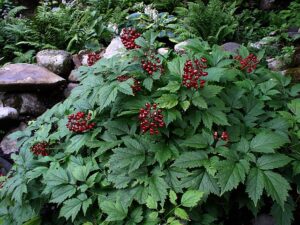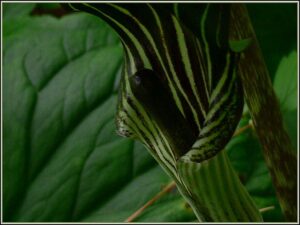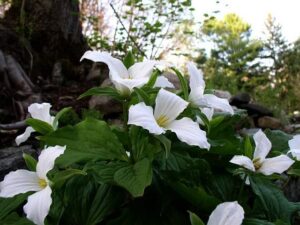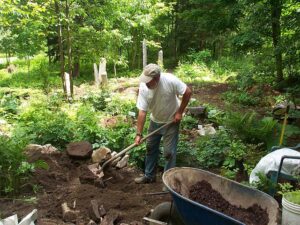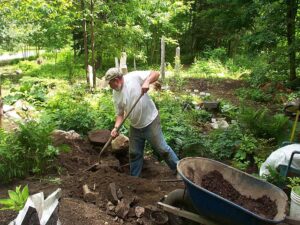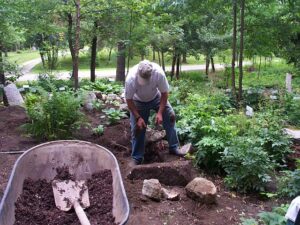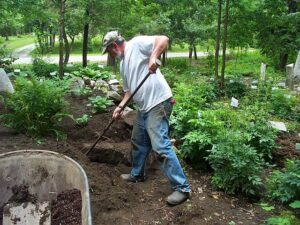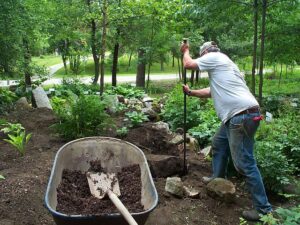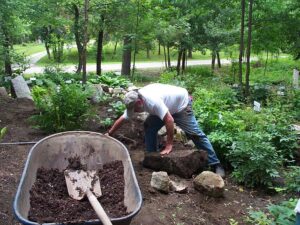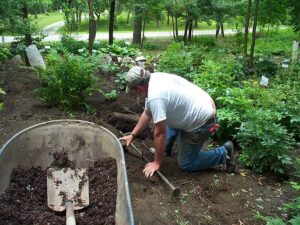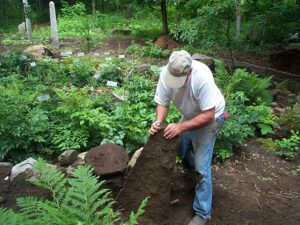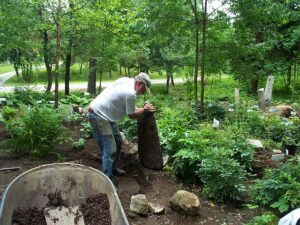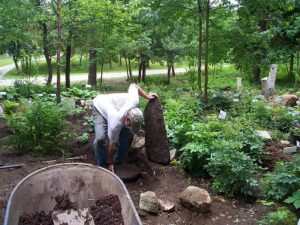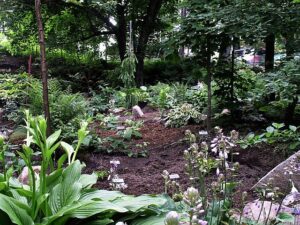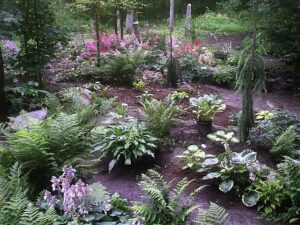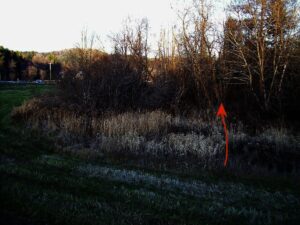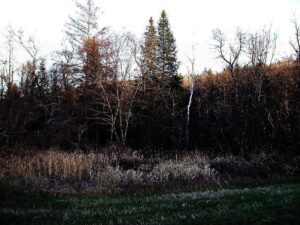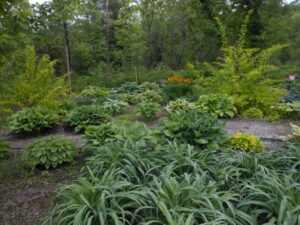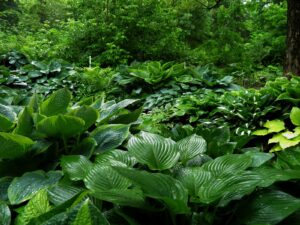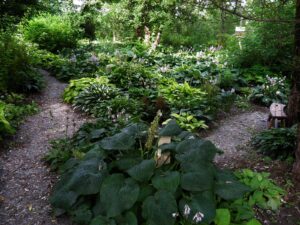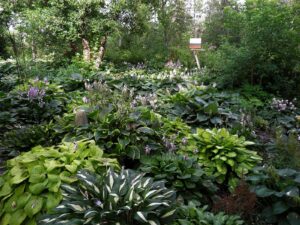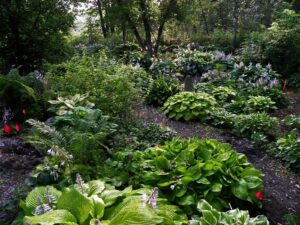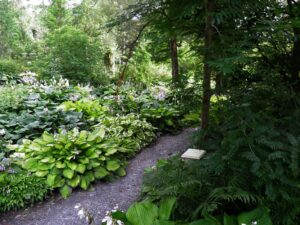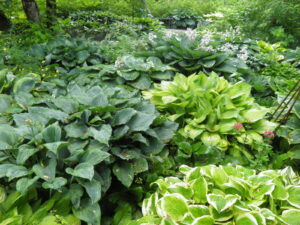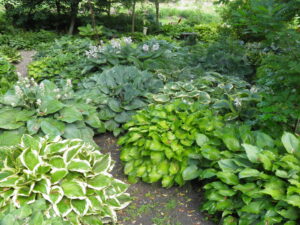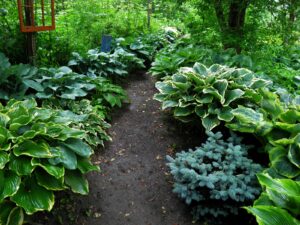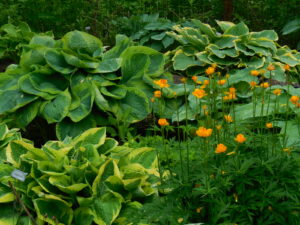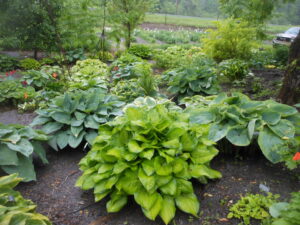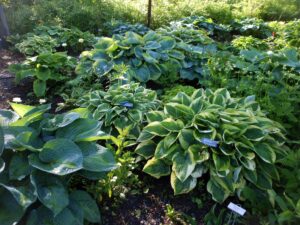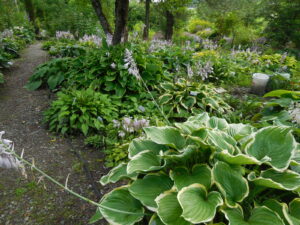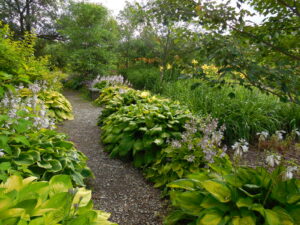Building Hosta Gardens
I wrote this first article on constructing a hosta garden for our old website after several customers told me I should summarize some of the thoughts I had as I took on a piece of history…an old barn foundation that burned down in 1902…and created a new garden within it. As I wrote, I kept getting hung up on historical thoughts and questions that lacked answers. Reflecting back now, I think this first article will serve as background to the second article about the new hosta display garden that we began in 2008 at our new nursery. Neither garden could ever be the same, but both past and present hosta display gardens provide tranquility and peace that is important to all garden visitors…especially in this time of monumental world change.
George Africa
First written in Winter 2008
Updated January 2021
BUILDING HOSTA GARDENS part 1
The Peacham Pond Road Garden
Breathing long sighs of both fatigue and relief, I sat back on the rough ground, pleased with the way the boulders were working into place. As I pushed myself back on the clay dirt, I carefully scanned for errant pieces of broken farm equipment, charred roofing or wall nails, shards of glass, old animal bones…anything which might cause injury to my progress. I was dirty and dripping wet but I sensed accomplishment.
The strength of this garden-to-be was an actual barn foundation constructed more than a century ago of glacier-tumbled fieldstones and irregular granite blocks hand quarried on the property. An old granite worker from Barre explained to me once that house or barn builders would locate a piece of granite they liked, hand drill a line of holes and then fill the holes with water and pound in poplar tree twigs (a softwood). Before winter the water would swell the twig and when it froze solid, the granite would crack. In later years, as the granite industry evolved, brass pins were used instead, placed in the holes and then pounded one after another in a line until the pieces of stone separated. An average piece of granite weighs about 95 pounds per cubic foot so the split pieces required some forethought as they were cut, stacked and slid into place.
I had walked the floor within the stone walls time and again trying to sort out where things would go. I uncovered several granite blocks which at one time guided the main wooden carrying beams upward. I purposefully left them in place, a permanent reminder of the geometry of the building.
I cleared tree roots from the front wall, straightened it, and leveled the dirt, front and back. Finally, I turned over the dirt within the only obvious room, a southwestern facing room, 12 X 14 feet in size. Was it the milk room in a dairy barn or a tack room in a stable? Insufficient evidence for an answer. A contemplative question, a mystery, to leave with visitors…sort of a remembrance dating to 1902.
Building gardens offers a reward that’s difficult to describe. Building this garden was especially important to me. I had procrastinated for several years, knowing full well that once started, the job would carry on for many years, perhaps as long as my health permitted. The foundation was historical of course but no one knew the history. I checked with passing travelers, especially those with graying hair or slow, deliberate gait, hoping that age might translate to reminiscence…to even a single piece of background from which to jumpstart a historical search…but still I waited. So from the remains of a once-stately country building, I began to work upon the building’s remaining strengths, and a hosta garden was born in the shade of one yellow birch, several maples, a giant green ash and a couple lesser wild apple trees.
Most people have respect for age. In people, it is perhaps an assumption of strong genes, perseverance and wisdom, but in other antiquities such as this foundation, it is more just a respect for time and survival. Lacking documentation, the foundation’s past remained animate only in our minds. The silver maple and the yellow birch each have noticeable girth. In circumference, the first is 54”, the second, 87”. They signify survival and strength as their limbs reach skywards. Each has many years of life left.
The confines of the walls and the umbrella-like shading from the tree canopy encouraged a shade garden. White and red baneberries, three varieties of trillium including grandiflorum, erectum, and undulatum, as well as arisaema…those Jack-in-the-pulpits kids love to open up and peer into, …and hay scented, Christmas and maidenhair ferns…each of these common wild flowers had already staked their claim on the dry floor bed.
Visitors regularly asked where the rocks came from and were surprised to find that they were here when we arrived in 1989. The accumulation of boulders up to three feet in diameter on the floor within the foundation walls was astonishing. It represents how intent some people are at getting the heavyweights off their property. The foundation which parallels a well-travel road had become a dumping ground of sorts and part of the discard was boulders cast off by those in whom they saw no beauty. I disagreed…
Aided by a 6 foot pry bar and some odd pieces of pipe, I began laying out the garden within the walls. I first pried the rocks away from the back wall and then, slightly off-center, prepared an area for a pre-formed pond liner. It is surprising how large a boulder you can manage yourself with a bar and pipe rollers if you think it through first. I backfilled with coarse sand to protect the liner and topped it off with wheelbarrow loads of “my” mix—peat, composted manures, sand, lime, alfalfa and maple leaves chopped fine the preceding fall. Backfilling to the foundation wall and to a depth of almost 3 feet on one end became a chore that didn’t seem to have an ending, but then again, 45 yards of compost is quite a pile, one wheelbarrow at a time!
From the back wall forward I dug individual holes for each plant and filled each one with the same soil mix. I dug each hole about 24” in diameter and equally as deep to ensure some longevity to the organic mass. I also hoped that the mix would hold moisture for a while in between rains. I proved to be wrong on that assumption but what I did was a good start…and then I started planting.
People ask about the garden, where the design came from, who sorted out the color combinations, the textures and the scape heights. Some inquiries seem to rigorously search for a complicated method of design when in fact I just plant, that’s right, I just plant. New gardens don’t look good the first year or two anyway unless they are “television gardens”. Real gardens are usually not planted with mature specimens and they require time to fill in. This particular garden was intended to mix cultivated and native plants worked around those that had already grabbed a foothold. I planned that in time, the mix would be impressive. Gardens have messages and they need to speak to visitors. This garden became the great conversationalist I wanted it to be.
I defined a number of little hideaways that focused attention on just three or four plants at a time and in so doing encourage mental discussion. This is not difficult to do but it takes patience to match the various dimensions. The little nook of Hostas ‘June’, ‘On the Marc’ and ‘Just So’ nestled among granite chips and overshadowed by ferns is an example. It exudes a special peace while emphasizing the trio’s individual qualities. Yes, this entire hosta garden became a peaceful place to visit. In my absence, it converses calmly with its visitors. It cannot be copied but it can serve as a model. In 2006, as we decided to move Vermont Flower Farm, our business, to a new property on Route 2, new time constraints caused us to walk away from what had become a beautiful shade garden admired by all. I made a map of where everything was planted and I promised myself that someday I would recreate that first shade garden as it was…a garden to enjoy for the balance of my gardening years. I still hold that plan. Here are some images of the building process.
One rock at at time!
BUILDING HOSTA GARDENS part 2
The Route 2 Garden
In the late summer of 2006, after looking for a piece of property close to our home in Marshfield but someplace along US Route 2, I heard of a piece of property just half a mile west of the village. I had never met the owner and I soon learned from locals that there were a couple-three people interested in buying it but none wanted to pay the asking price. Since I had been looking for land with greater visibility than on Peacham Pond Road, and knew that nothing came close to this piece, I moved quickly. I offered the asking price, cash sale, no contingencies and closing as soon as possible. Gail and I walked the land with the owner and a friend who is a realtor. The land was a bit more than 4.25 acres, was bordered by Route 2 for 845 feet on one side and by the Winooski River for 502 feet on the south side. The eastern corner was bordered by a +1 acre parcel owned by the State of Vermont so the piece was quite well protected. We agreed to the purchase in short order and so began Vermont Flower Farm and Gardens, a perennial flower business that continued what we had started on Peacham Pond Road.
Our plan was to spend a year fencing the property, building an office/storge building, installing electricity and water, preparing the gardens, transplanting thousands of plants from Peacham Pond Road and then opening there for business in 2008. The fence was the first priority because there was a deer yard just across the Winooski River on one side and a neighbor across Route 2 had regularly fed deer on his property until the law changed. That meant that whitetails were accustomed to grazing on property that was destined for flowers. The fence went up and the plan progressed. Each night I would come home from a regular job and load the truck with crates of perennials that Gail had dug, washed and divided during the day. Then I would plant until sundown. By the end of fall of the second year, I had planted over 3000 plants across 26-10′ X 50′ gardens.
When we purchased the property we had plans for an extensive shade garden on the eastern end. Our first impression was that the area was a swamp of sorts with alders and wild grasses and a few cattails. I began clearing the half-acre space and by the fall of the first year it was cleared and by the following summer, planting could commence. Here is what it looked like when we started.
After removing dozens of truckloads of brush and debris, we pulled out all the stumps and then used the tractor to rototill around the remaining trees. As I began planting hostas, I noticed that almost every hole that I dug was a different mix from mason’s sand to large stoned gravel. It made no sense to me that there should be such a diversity of material all within 100 feet or less of the river. I began asking local folks if they knew anything about the land. Anytime I went to the gas station or the village store I would ask any older people if they could help with the answer. Finally, one day as I was on my hands and knees planting some hostas, a man startled me from behind. He was looking for some flowers for his mother and also wanted to know what I was doing. I asked him if he knew what the history of the land was. “This is where Ma came every day in the summer.” The response continued. “She’d come down here every day just before 5 and tell all the kids to go home for supper.” My face must have shown my confusion. “You know where the swimmin’ hole is right?”, he asked. It was then that the man told me that where I was standing was where the village highway crew and also the state highway crew stockpiled various products to make and maintain the roads which back then were dirt roads. The village kids played on the sand piles and swam in the river. I asked the guy if his mother ever had trouble with kids that didn’t follow her direction. He thought for a minute and replied “Just once.” Mystery solved.
If you have gardened for a while you probably have been involved in a debate about soil. Is clay soil or sandy soil the preferred soil to begin to work with? My new shade garden was sand through and through but 100 feet away the soil type changed to clay since it sat at the bottom of the Winooski Ocean 15,000 years previous. 3 years later I worked with a federal agricultural program and the entire +4 acres was sampled and soil types were identified. Once you know what you do and don’t have to start with, you can begin to build better soil and grow better plants. Today this garden holds over 600 different hostas, and a nice assortment of primulas, Astilboides tabularis, actaea, brunnera, pulmonaria, a few dwarf conifers and various other perennial flowers. In each case with the flowers, I have over-dug the planting holes and amended the soil with aged cow manure and shredded and composted maple leaves. I also added magnesium sulfate to each hole as it stimulates root growth in all plants. Today the garden requires annual additions of organic dressing since the preponderance of sand offers no nutrition by itself. Come tour the garden and see for yourself what has grown from a piece of land that was alders, willows, cattails and wild grasses. The pictures that follow show what it has become.
